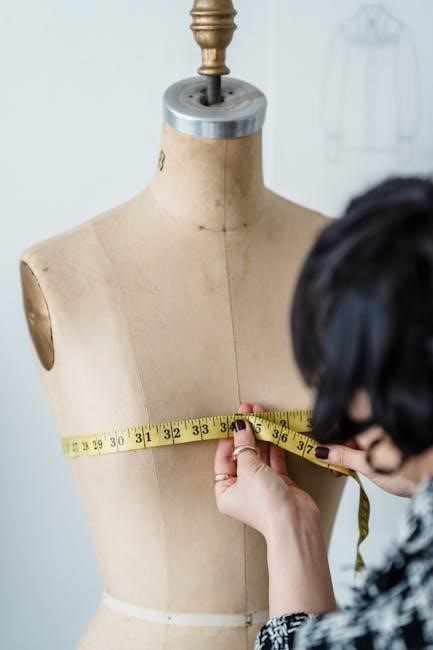Clothing size guides are essential tools for online shopping, helping consumers choose the perfect fit. They eliminate guesswork, reduce returns, and provide consistency across brands and sizes.

1.1 What Are Clothing Size Guides?
Clothing size guides are standardized charts that help consumers determine their best fit for garments. They provide measurements for bust, waist, hips, and other body dimensions, ensuring accuracy. These guides vary by brand and region, reflecting different sizing standards worldwide. They often include numerical or alphabetical sizes, such as XS to XXL, and cater to diverse body types, including plus-size and maternity ranges. By referencing these guides, shoppers can make informed purchases, especially online, where trying items on isn’t possible. They also help brands maintain consistency, reducing sizing inconsistencies and enhancing customer satisfaction.
1.2 Importance of Using Size Guides for Online Shopping
Using clothing size guides is crucial for online shopping, as they help eliminate guesswork and ensure the best fit. Without trying items on, size guides provide accurate measurements, reducing the likelihood of returns. They save time and frustration by offering clear comparisons between brands and sizes. Additionally, size guides boost confidence in purchases, especially for shoppers unsure about fit. They also cater to diverse needs, including plus-size, maternity, and international sizing, making online shopping more inclusive and convenient. By referencing these guides, consumers can enjoy a seamless and satisfying shopping experience from the comfort of their homes.

Understanding Body Measurements
Accurate body measurements are key to finding the perfect fit. They help determine your size by focusing on bust, waist, and hips, ensuring a smooth shopping experience.
2.1 How to Measure Your Bust, Waist, and Hips
To measure your bust, wrap a tape measure under your arms and around the fullest part of your chest, keeping it level and snug. For the waist, measure just below your natural waistline, around the narrowest point of your torso. To measure your hips, stand with your feet together and wrap the tape around the fullest part of your hips, approximately 8 inches (20 cm) below your waistline. Ensure the tape is straight and not twisted for accurate results. These measurements are crucial for selecting the right clothing size and ensuring a proper fit.
2.2 Tips for Accurate Body Measurements
For precise body measurements, use a flexible tape measure and stand upright. Keep the tape snug but not overly tight, ensuring it’s parallel to the floor. Measure over the undergarments you normally wear to ensure accuracy. When measuring your bust, take it around the fullest part, keeping the tape level. For the waist, find your natural indentation and measure without sucking in. For hips, stand with feet together and measure around the widest point. Avoid twisting the tape, and take multiple measurements to confirm accuracy; Consistency in technique ensures reliable results for comparing with size charts.

Standard Clothing Size Charts
Standard clothing size charts provide uniform measurements for men and women, ensuring consistency across brands. They include detailed measurements for bust, waist, and hips, aiding accurate size selection.
3.1 US Clothing Size Chart for Women
The US clothing size chart for women provides standardized measurements for garments. Sizes range from XS to XXL, corresponding to numerical sizes 0-26. The chart includes bust, waist, and hip measurements, ensuring accurate fits. For example, a size 6 typically corresponds to a bust of 33.5-34.5 inches, a waist of 26-27 inches, and hips of 35.5-37.5 inches. These measurements help consumers choose the right size, reducing the need for returns. However, variations exist between brands, so checking individual brand charts is recommended for the best fit.
3.2 US Clothing Size Chart for Men
The US clothing size chart for men is based on body measurements, primarily chest size. Sizes range from Small to 6XL, with numerical equivalents like 28-40 for pants. Chest measurements typically determine shirt sizes, with Small fitting 34-36 inches, Medium 38-40 inches, and so on. Waist measurements are also crucial for pants, ensuring a comfortable fit. These charts help men choose garments that align with their body measurements, though variations exist across brands. Using these guides reduces fitting issues and enhances shopping confidence, whether online or in-store.
3.3 International Size Comparisons (US, UK, EU, etc.)
International size comparisons are crucial for global shopping, as sizing standards vary significantly across regions. For instance, a US size 8 in women’s clothing corresponds to a UK size 12 and an EU size 36. Similarly, men’s sizes differ, with a US Medium often equating to a UK Medium but varying in chest and waist measurements. Japan and Russia also have unique systems, requiring conversion charts to match sizes accurately. These comparisons help shoppers avoid discrepancies and ensure a consistent fit when purchasing from international brands or retailers. Always consult size charts for precise conversions to guarantee the best fit.

How to Choose the Right Size
Choosing the right size involves understanding your measurements, comparing them to size charts, and considering fit preferences. Always double-check brand-specific guides for accurate sizing.
4.1 Understanding Fit Preferences (Slim, Regular, Loose)
Fit preferences determine how clothing drapes on the body. Slim fit garments are tailored closely, offering a modern, streamlined look. Regular fit provides a classic, comfortable silhouette with a bit more room. Loose fit styles are relaxed, allowing maximum comfort and a casual appearance. Understanding these preferences helps match your lifestyle and fashion goals, ensuring optimal comfort and style. Always refer to size charts for specific measurements, as fit preferences vary between brands and garments.
4.2 How to Use Size Charts for Different Garments
Using size charts effectively requires matching your measurements to specific garments. For dresses and tops, focus on bust and chest measurements. Pants and jeans rely on waist and hip measurements. Jackets and coats may require chest and shoulder measurements. Always consider the fit preference (slim, regular, or loose) and fabric type, as stretchiness can affect sizing. Double-check the chart for the exact garment type to ensure accuracy. This approach minimizes sizing errors and helps you select the perfect fit for your body and style preferences when shopping online or in-store.

Brand-Specific Size Guides
Brand-specific size guides vary across labels, with popular brands like ASOS, Levi’s, and Nike offering tailored charts. These guides account for unique fits and styles, ensuring accuracy.
5.1 Popular Clothing Brands and Their Sizing Standards
Popular brands like ASOS, Levi’s, and Nike provide detailed size charts tailored to their designs. ASOS offers fit guides for women, men, and kids, aligning with body measurements. Levi’s sizing focuses on denim, measuring waist and inseam accurately. Nike’s charts cater to athletic fits, ensuring comfort and performance. H&M and Zara adapt their sizes to global trends, while luxury brands like Armani maintain precise, high-quality standards. These guides help consumers find the perfect fit, reducing sizing mismatches and enhancing shopping experiences. Accurate measurements and consistent updates make these charts reliable for online purchases.
5.2 How Brand Variations Affect Sizing
Brand variations significantly impact sizing consistency, as each brand tailors its measurements to specific fits and designs. For instance, ASOS and H&M may differ in how they define “medium,” while luxury brands like Armani often use precise, high-end standards. Additionally, some brands cater to specific body types, such as petite or plus-size ranges, further diversifying sizing. These variations can confuse consumers, even when measurements remain consistent. Understanding these differences is crucial for accurate purchases, as sizing standards are not universal across brands or regions. Always refer to individual brand guides for the best fit.

International Size Conversion
International size conversion ensures global shoppers find their perfect fit by aligning clothing sizes across regions. Tools and charts help convert US, UK, EU, and other sizes accurately.
6.1 Converting US Sizes to UK Sizes
Clothing size conversion between US and UK systems is essential for international shoppers. US sizes are typically labeled with letters (XS-XXL), while UK sizes use numerical values (6-24). Generally, UK sizes are 2-4 sizes ahead of US sizes. For example, a US size 8 corresponds to a UK size 12. This guide helps shoppers navigate differences in sizing standards, ensuring a better fit. Use size charts or conversion tools for accuracy, as variations exist between brands. Always check specific brand guidelines for precise measurements to avoid discrepancies. Accurate conversion enhances shopping confidence and reduces the need for returns.
6.2 Converting US Sizes to European Sizes
Converting US clothing sizes to European sizes requires understanding their numerical differences. US sizes often use letters (XS-XXL), while European sizes use numbers (32-58). Women’s sizes align closely, with US 4 equating to EU 32 and US 12 to EU 42. Men’s sizes also follow a similar pattern, with US Medium typically corresponding to EU 50. This guide helps shoppers avoid confusion when purchasing from European brands. Use detailed size charts for accurate conversions, as sizing may vary slightly by brand. Check specific measurements to ensure the best fit and minimize returns. Accurate conversion enhances global shopping experiences.
6.3 Global Size Charts for Dresses, Jackets, and Pants
Global size charts provide a standardized reference for dresses, jackets, and pants across international markets. They include measurements for bust, waist, hips, chest, and inseam, ensuring consistency. These charts are invaluable for cross-border shopping, as they align US, UK, EU, and other sizes. For dresses, measurements focus on bust and hip circumference, while jackets and pants emphasize chest and waist. Inseam lengths are standardized for pants. While global charts simplify comparisons, slight variations exist between brands. Always check specific measurements for the best fit and to minimize returns. This approach ensures a seamless shopping experience worldwide.

Specialized Sizing Needs
Specialized sizing addresses unique fit requirements, such as plus-size, maternity, and vintage clothing. These guides ensure comfort and style for diverse body types and preferences globally.
7.1 Plus-Size Clothing Guides
Plus-size clothing guides cater to individuals with larger body measurements, ensuring a comfortable and flattering fit. These guides typically include extended size ranges, often starting from size 14 or 16. Measurements for bust, waist, and hips are tailored to accommodate curvier figures, with a focus on proportional sizing. Many brands now offer plus-size options, reflecting the diversity of body types. The guides emphasize the importance of accurate measurements to find the perfect fit. They also highlight the variety of styles available, from trendy to timeless, ensuring inclusivity and confidence for all shoppers.
7.2 Maternity Clothing Size Charts
Maternity clothing size charts are designed to accommodate the body changes during pregnancy, ensuring comfort and style. These charts typically align with pre-pregnancy sizes but offer flexibility for a growing belly. Measurements focus on bust, waist, and hips, with adjustments for the expanding abdomen. Some brands use numerical sizing, while others opt for letter sizes like S, M, or L. Accurate measurements are crucial for the best fit, often taken under the bust and around the natural waistline. Maternity size charts also cater to international conversions, making it easier for expectant mothers to find flattering and comfortable clothing worldwide.
7.3 Historical and Vintage Sizing Standards
Historical and vintage sizing standards differ significantly from modern systems, often based on era-specific tailoring and fit preferences. In the past, clothing sizes were less standardized, with measurements varying by region and era. For example, Victorian-era garments were tailored to individual measurements, while 1920s fashion emphasized a more free-spirited, less structured fit. Vintage sizing often used descriptive terms like “small,” “medium,” or “large” rather than numerical sizes. Today, many brands recreate vintage styles but adapt sizing to modern standards, ensuring historical aesthetics meet contemporary fit expectations. Understanding historical sizing can help enthusiasts of vintage fashion find accurate, flattering garments.

Measuring for Specific Garments
Accurate measurements ensure the best fit for jeans, shirts, dresses, and coats. Use a flexible tape measure, keep it level, and align it properly for precise sizing.
8.1 How to Measure for Jeans and Pants
Measuring for jeans and pants requires precision to ensure a perfect fit. Start by identifying your natural waistline, typically just above the hipbone. Measure around this area with a tape measure kept level and comfortable, not too tight or loose. Next, measure your hip circumference about 8 inches (20 cm) below your waistline, ensuring the tape is parallel to the floor. For the inseam, measure from the base of the crotch to the bottom of the ankle; These measurements will help you determine your ideal size for a comfortable and flattering fit.
8.2 How to Measure for Shirts and Jackets
Measuring for shirts and jackets involves a few key steps to ensure the best fit. Start by measuring your chest circumference, placing the tape measure under your arms and around the fullest part of your bust, keeping it level and snug. Next, measure your shoulder length from the base of one shoulder to the other, ensuring the tape is straight. For jackets, also measure the length you prefer, typically from the base of the neck to the desired hemline. These measurements will help you choose the right size for shirts and jackets, ensuring comfort and style.
8.3 How to Measure for Dresses and Coats
Measuring for dresses and coats requires attention to key areas for a perfect fit. Start by measuring your bust, ensuring the tape is snug and level around the fullest part. Next, measure your natural waistline, just above the hipbone, and your hips at their widest point, about 8 inches below the waist. For dresses, consider the desired length, whether it’s midi, maxi, or knee-length. For coats, measure your shoulder width and sleeve length if needed. Use a flexible tape measure and stand straight to ensure accurate results. These measurements will help you find the ideal size for dresses and coats, ensuring comfort and style.

Tools and Resources
Utilize online size converters and mobile apps for precise measurements. These tools help compare sizes across brands and countries, ensuring a perfect fit every time.
9.1 Online Size Converters
Online size converters are invaluable for shoppers, enabling seamless size comparisons across brands and countries. These tools allow users to input their measurements and instantly find equivalent sizes globally. Whether converting US sizes to UK or EU standards, these platforms ensure accuracy. Many converters cater to specific garments, such as dresses, jackets, or pants, providing precise fits. They often include detailed charts and guides, making international shopping effortless. By eliminating confusion, online size converters save time and reduce the likelihood of incorrect purchases, fostering confidence in finding the perfect fit for any item, anywhere in the world.
9.2 Mobile Apps for Size Measurements
Mobile apps for size measurements offer a convenient way to determine clothing sizes. These apps use body measurements to recommend sizes across various brands and styles. Many apps feature scanning technology, allowing users to input their measurements and receive tailored size recommendations. They often support international size conversions, making global shopping easier. Some apps also store measurements for future purchases, streamlining the shopping process. By providing accurate and personalized sizing solutions, these apps reduce the hassle of returns and ensure a better fit, making them indispensable for modern shoppers seeking convenience and precision in their fashion choices.
Clothing size guides empower shoppers to find the perfect fit, ensuring confidence and satisfaction. Accurate measurements and the right tools make every purchase effortless and enjoyable.
10.1 Key Takeaways for Finding the Perfect Fit
Accurate body measurements are crucial for selecting the right size. Always refer to size charts specific to the brand and garment type. Understand your fit preference—slim, regular, or loose—to ensure comfort. Be aware of brand variations, as sizing can differ significantly. International size comparisons can help when shopping across borders. Specialized sizes, such as plus-size or maternity, require tailored guides. Use online tools like size converters for convenience. Lastly, don’t hesitate to try clothes on if possible, as fit can vary even with precise measurements. These tips ensure a confident and satisfying shopping experience.
10.2 Final Tips for Using Size Guides Effectively
Double-check measurements against size charts for accuracy. Consider fabric stretch and style when selecting sizes. Use fit preferences like slim or loose to tailor choices. Compare international sizes if shopping globally. Check brand-specific guides, as sizing varies. For specialized needs, like plus-size or maternity, use dedicated charts. Utilize online tools and apps for easy conversions. Regularly update your measurements to ensure accuracy. Don’t rely solely on previous purchases, as sizes can change. Always review return policies for online orders; By following these tips, you can shop with confidence and achieve the best fit every time.

